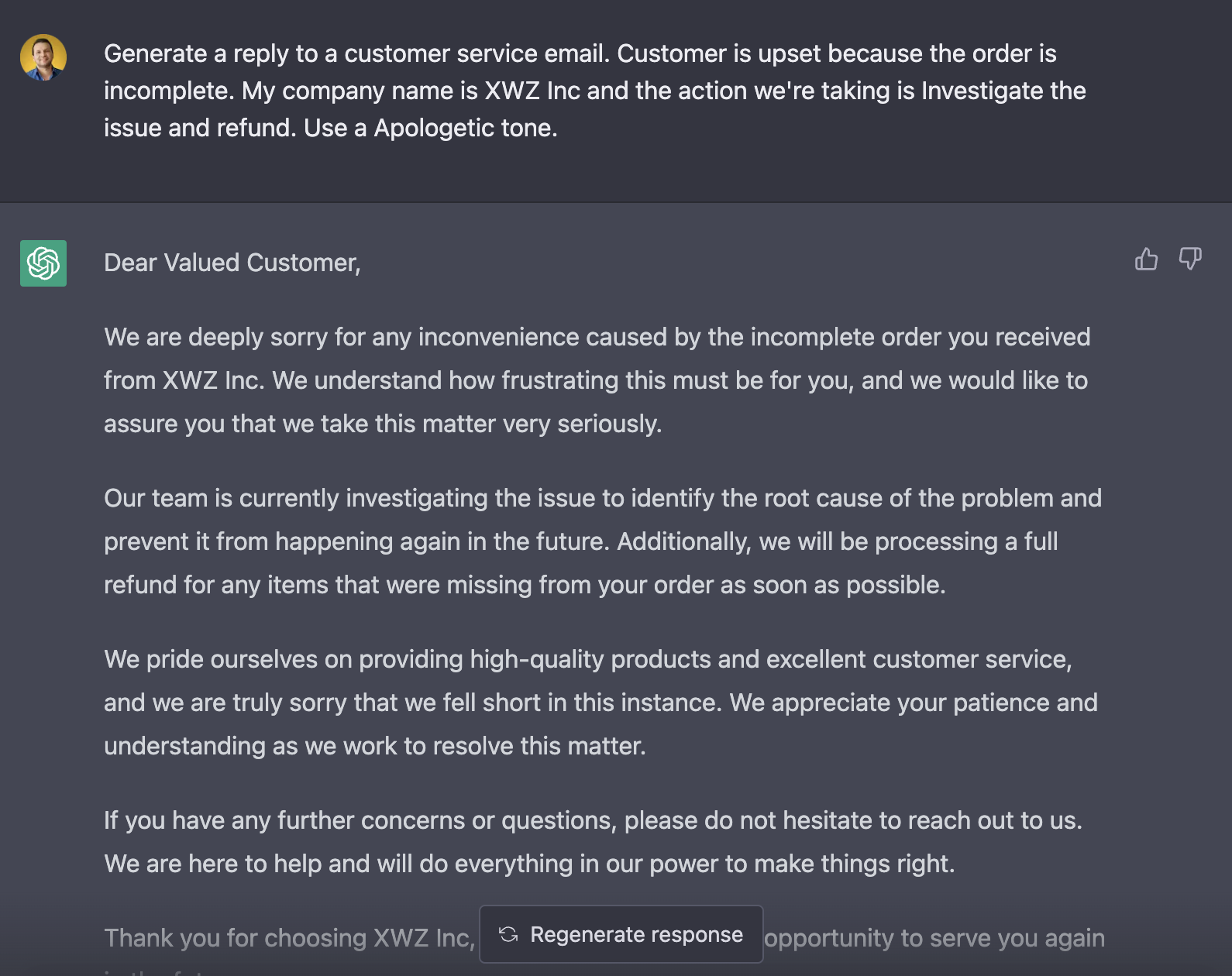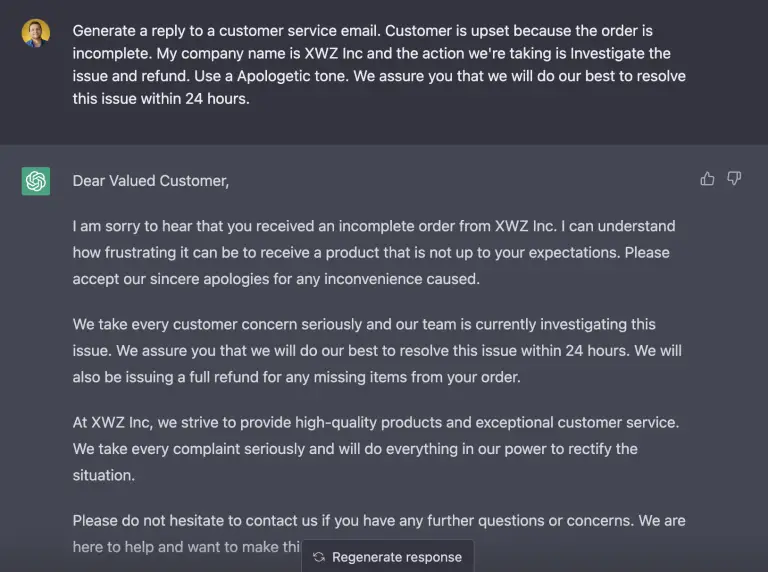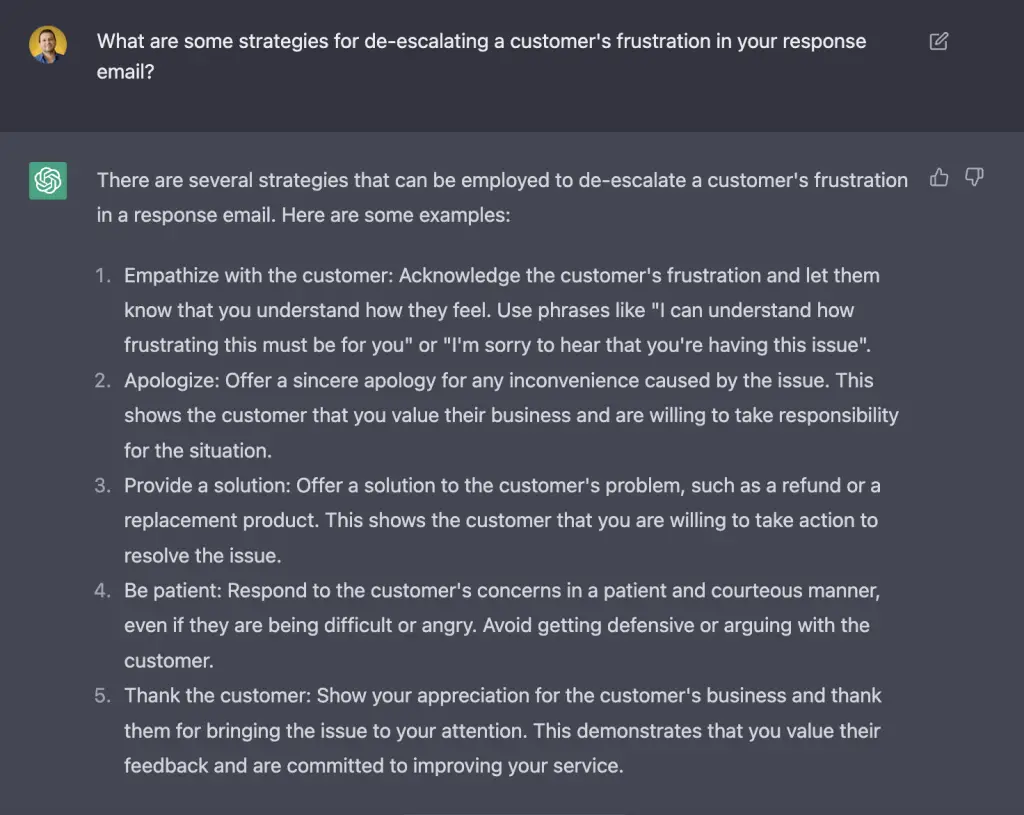The Prompt
You can copy this prompt in the upper-right corner.
Generate a reply to a customer service email. Customer is upset because {Upsetting reason}. My company name is {Business name} and the action we're taking is {Action to solve issue}. Use a {Tone style} tone.
What results should I expect from using this prompt in ChatGPT?
Welcome to the future of customer service! As businesses embrace the power of artificial intelligence, ChatGPT has become the go-to tool for resolving conflicts with ease. In this article, we’ll explore how you can use ChatGPT to handle angry customers, providing them with prompt and satisfactory solutions. So, let’s dive into the world of customer service, AI style.
Effective communication is crucial when dealing with unhappy clients. It’s essential to keep your language positive, easy to understand, and approachable. To achieve this, we’ll focus on using short sentences, active voice, and contractions. By minimizing adverbs and maintaining a readable vocabulary, your customers will feel valued and understood.
Now, let’s break down the ChatGPT prompt that will enable you to handle angry customers like a pro:
“Generate a reply to a customer service email. Customer is upset because {Upsetting reason}. My company name is {Business name} and the action we’re taking is {Action to solve issue}. Use a {Tone style} tone.”
This powerful prompt allows you to craft a personalized and empathetic response to your customer’s concern. To use it, simply fill in the blanks with the relevant information:
- {Upsetting reason}: Identify the cause of the customer’s dissatisfaction.
- {Business name}: Insert the name of your company.
- {Action to solve issue}: Describe the steps you’re taking to resolve the problem.
- {Tone style}: Choose the appropriate tone for the situation, e.g., empathetic, apologetic, or assertive.
But when should you use this prompt? Here are a few scenarios where ChatGPT can come to your rescue:
- Responding to a complaint about delayed delivery: ChatGPT can generate a prompt reply expressing your understanding, explaining the reasons for the delay, and offering a solution, such as rescheduling the delivery or providing a refund.
- Addressing concerns about product quality: When customers are unhappy with the quality of your products, ChatGPT can help by crafting a response that acknowledges their dissatisfaction, explains your quality control measures, and offers a replacement or refund.
- Dealing with billing disputes: If a customer is upset about a charge on their account, ChatGPT can provide an explanation, investigate the issue, and suggest a resolution, like a refund or account credit.
By leveraging the power of ChatGPT, you can ensure that your customers feel heard and valued, no matter the issue at hand. By using this prompt and following our guidelines for effective communication, you’ll be well on your way to providing top-notch customer service that keeps clients coming back for more.

Prompt Variables
How to modify the prompt? See examples of how to change the variables between curly brackets
| Variable | Description | Examples | Complete prompt with example |
|---|---|---|---|
| Upsetting reason | Reason for customer's upset | Delayed delivery, incomplete order, wrong color | Customer is upset because {Delayed delivery} |
| Business name | Name of the company | XYZ Inc. | My company name is {XYZ Inc.} |
| Action to solve issue | Action taken by the company to solve the issue | Offering a refund, Investigate issue, money return | and the action we're taking is {offering a refund} |
| Tone style | Tone of the reply | Apologetic, sympathetic, friendly | Use a {apologetic} tone. |
Prompt use scenarios
Here are 5 examples of different situations, where this ChatGPT prompt could be useful.
Upset Customer
Customer is upset due to a specific reason
Delayed Delivery
Customer is upset due to delayed delivery of the product
Wrong Product
Customer received the wrong product and is upset
Billing Issue
Customer is upset due to a billing issue
Poor Customer Service
Customer is upset due to poor customer service
Additional variables ideas for this prompt
You can improve this ChatGPT prompt by using the following variables.
| Variable | Description | Examples | Prompt Variation |
|---|---|---|---|
| {Customer name} | Name of the upset customer | John Smith, Jane Doe | Dear {Customer name}, we apologize for the inconvenience caused by {Upsetting reason}. |
| {Product name} | Name of the product or service in question | iPhone, Netflix subscription | We understand your frustration with {Product name} not meeting your expectations. |
| {Compensation type} | Type of compensation being offered | Refund, discount code | As a gesture of goodwill, we would like to offer you a {Compensation type} for the inconvenience caused. |
| {Resolution time} | Estimated time to resolve the issue | 24 hours, 3 business days | We assure you that we will do our best to resolve this issue within {Resolution time}. |
| {Empathy statement} | Statement expressing empathy towards the customer | We understand how frustrating it can be when things don't go as planned. | We are truly sorry to hear that you have experienced {Upsetting reason} and we want to help in any way we can. |
Let’s try the Resolution time variable by adding a 24 hour deadline to solve the issue. This type of prompt interaction, it’s called Incremental prompts. Here are the results:

Conversation continuity
How can you use empathy in your response to a customer service email?
What are some effective ways to apologize to a customer in your response email?
How can you ensure that your response email is clear and concise?
What are some strategies for de-escalating a customer's frustration in your response email?
How can you use positive language in your response email to reassure the customer that their issue is being resolved?
I think we all can learn from this prompt idea:
“What are some strategies for de-escalating a customer’s frustration in your response email?”
Now, let’s try it out and see what results we get.

Attributes of the Prompt
From this ChatGPT prompt, we can learn several things that can be used in other contexts:
Clarity
The prompt is clear in its instructions and expectations.
Specificity
The prompt is specific in terms of what needs to be included in the reply and the context of the situation.
Context
The prompt provides context for the situation, including the reason for the customer’s upset and the action being taken by the business.
Tone
The prompt specifies the tone that should be used in the reply.
Style
The prompt does not specify a particular style for the reply.
Open-ended vs Closed-ended
The prompt is open-ended in terms of the specific wording and phrasing of the reply, but closed-ended in terms of the overall structure and content.
InstructGPT words
The prompt includes several instructGPT words, such as “”generate”” and “”use.””
Overall, the attributes of this prompt are useful in other contexts where clear and specific instructions are needed, but some flexibility is allowed in terms of the specific wording and phrasing. The inclusion of context and tone specifications can also be helpful in guiding the response.
Issues you can face when using this prompt in ChatGPT
As an AI language model, ChatGPT is capable of generating a reply to a customer service email. However, there are several issues that users may face when using this prompt. Here are some of them and possible solutions:
- Lack of context: The prompt only provides a general structure for the reply, but it doesn’t give any specific details about the customer’s issue or the company’s product/service. This can make it difficult for ChatGPT to generate a relevant and helpful response. To overcome this issue, users should provide as much context as possible when using the prompt, including the customer’s name, the specific problem they’re facing, and any relevant information about the company’s product/service.
- Inappropriate tone: The prompt allows users to specify the tone style for the reply, but it doesn’t provide any guidance on what tone would be appropriate for different types of customer complaints. This can lead to responses that are either too formal or too casual, which can further upset the customer. To avoid this issue, users should consider the nature of the customer’s complaint and choose a tone that is empathetic, professional, and respectful.
- Limited language capabilities: While ChatGPT is capable of generating human-like responses, it may not always be able to understand the nuances of customer complaints or provide the most effective solutions. This can result in responses that are generic or unhelpful, which can further frustrate the customer. To address this issue, users should review and edit the response generated by ChatGPT to ensure that it accurately reflects the customer’s issue and provides a clear and actionable solution.
- Privacy concerns: Depending on the nature of the customer’s complaint, there may be privacy concerns that need to be addressed when using ChatGPT. For example, if the customer has provided sensitive information such as their account number or personal details, it may not be appropriate to use an AI language model to generate a response. To avoid this issue, users should review their company’s privacy policies and ensure that they are following best practices for handling customer data.








